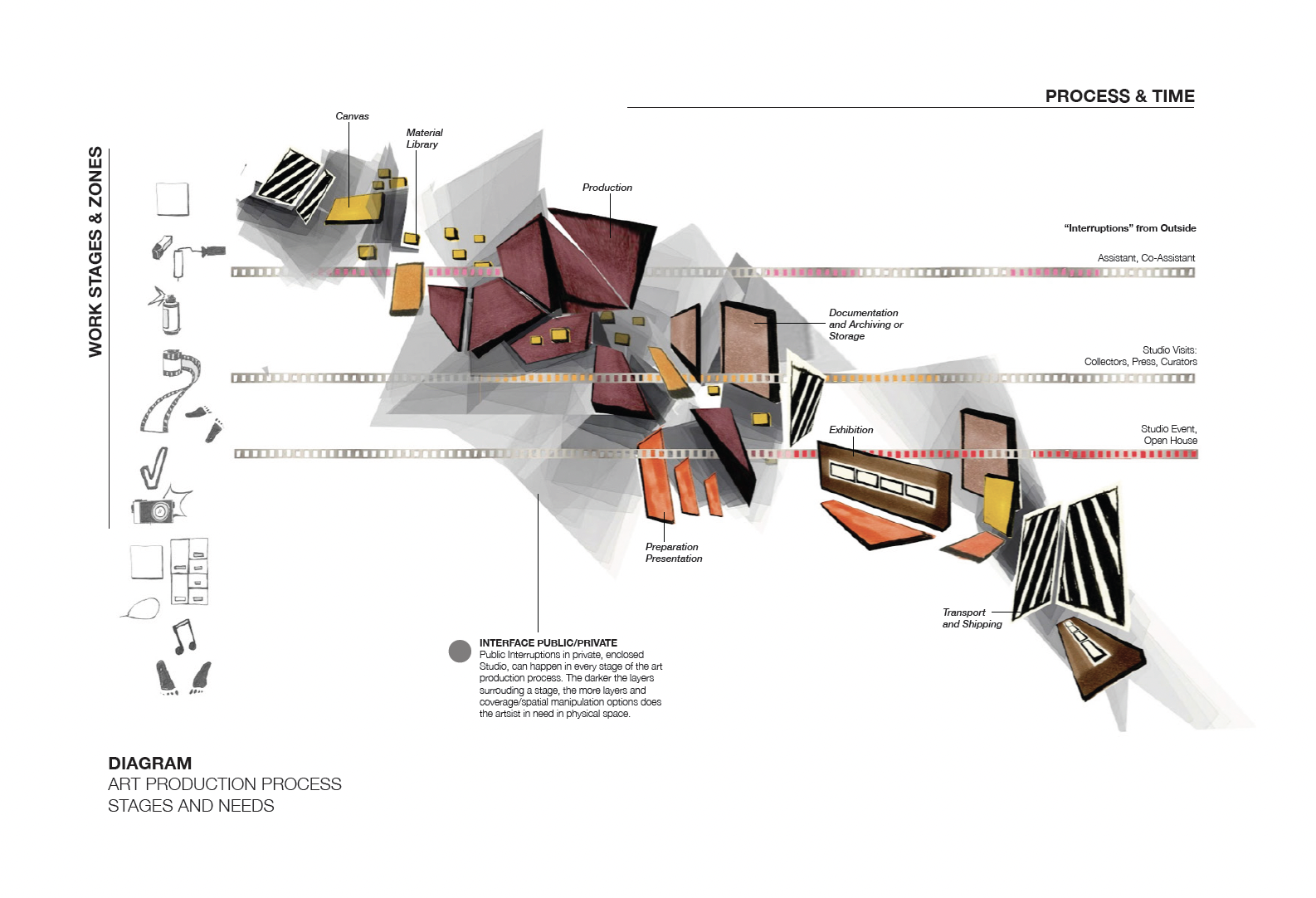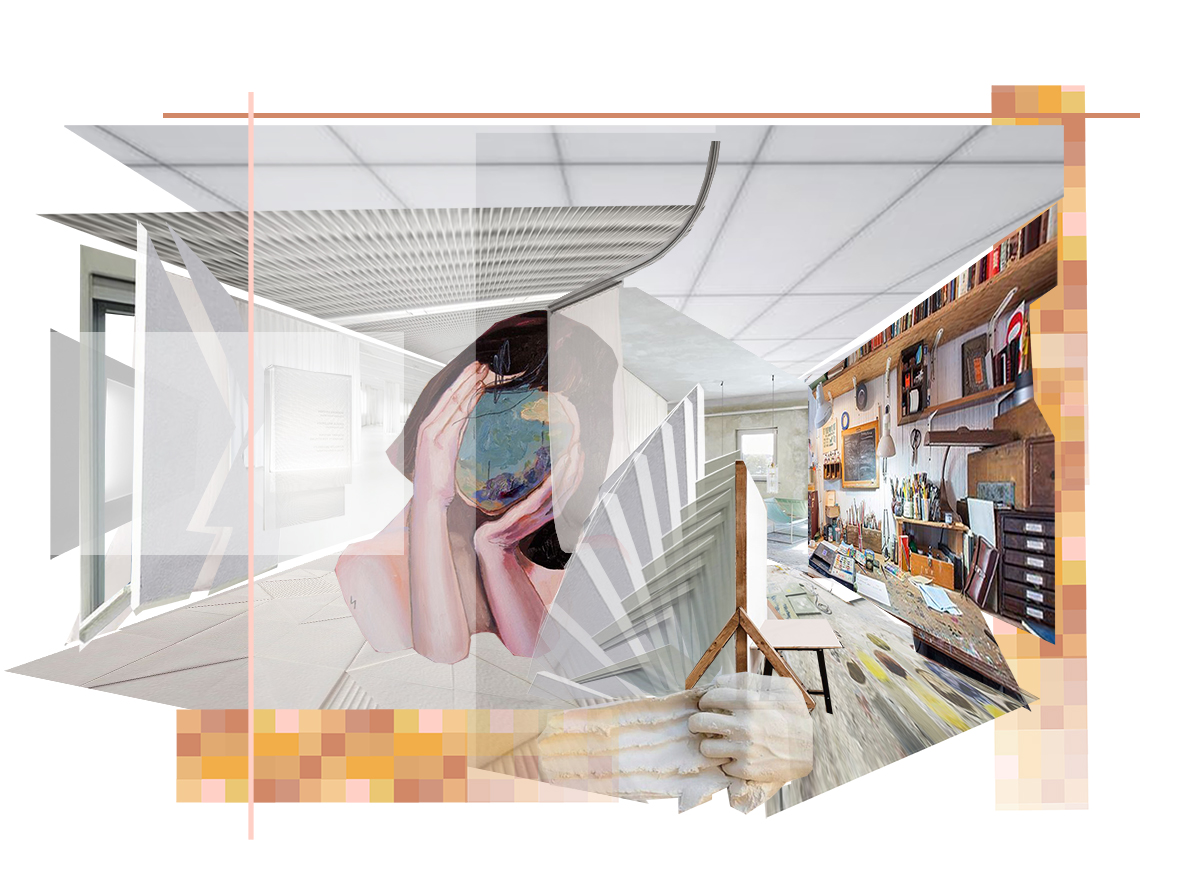Pixelfarm | Reimagine Artist Studios in a Phyigital World

Exploring the shift in art production, consumption, storage processes and examines the ways an interior designer can develop thresholds between the online and offline realms connected to an artist’s entire process of making.
SOCIAL PHENOMENA: EAVESDROP
New York, February 2020: A paradox phenomena observed in New York’s subway; “People constantly seek for connection with others through their phone. Seldom to the person standing 1-inch next to them. We seem to have lost touch in the physical, while we’re constantly escaping into the digital realm to find closeness and connection”. The frame of the phone becomes a window to life. The door to other dimensions. Almost infinte. But what happens to the physical? And what does this mean for an artist producing physically in digital age?
![]()
MANIFESTO
Private and public a topic also related to the current global pandemic. We experience how isolation continues forcing the fading of the space between digital and real life. Events, communication, everything happens through screens and we morph to a distant society. The closedness opens our minds. We become aware of how fragile our systems are. How mass mobility finds an end. The globalization has no more air. The tele-society becomes reality. “The others” become the infected ones. The ones we need to protect ourselves from in physical space. We’re out of touch but reconnected in digital streams.
TECHNOLOGY DISRUPTS THE WAY WE CURATE, EXPERIENCE AND PRODUCE ART
The way communication technology changes, also affects the way people encounter art or think of their art experience. Physical art spaces transform commercialized immersive rooms and become designated escape spaces for producing content that can be shared anreplicated online to a wider audience. Today, almost everyone with a smartphone can be a digital curator within the range of Internet services. As a result, art becomes very accessible and replicable. User-generated content tools offered through platforms from facebook to pinterest, tumblr or Instagram; the Internet generates a data explosion, a surplus from bloggers to rebloggers.
THE DESIGNERS ROLE
As designers, our intuition and empathy are our most valuable skills in order to respond to change. In times of the global pandemic this means designing for survival. We are reminded of the essential human need: To connect with each other, in person or remotely. And to produce and experience art as a remedy. But high-gloss flat screens cannot replace the intimacy of touch and the feeling of presence when experienced in a shared room. Even worse, digital can dilute the value of art when experienced on the screen in the minute of a swipe. This gives the role of the interior designer a prominent new challenge.
SCOPE & METHODS
Art and life still are produced in space first. It is the designers role to set the appropriate stage with the thresholds that let us flip from offline to online, as well as public and private. The artist studios therefore become designated stages with surfaces that allow for privacy, display and digital or physical friendly perspectives to experience and stretch the art production process across distance and time.
FRAMES Depending in what stage of art making the artist is at, he/she might need a physical or digital frame or both. Art production, consumption & storage process requires physical or a digital frames depending on the stage the artist’s at. The full concept and a suggestion for a first prototype is is presented in the project video (left).
SOCIAL PHENOMENA: EAVESDROP
New York, February 2020: A paradox phenomena observed in New York’s subway; “People constantly seek for connection with others through their phone. Seldom to the person standing 1-inch next to them. We seem to have lost touch in the physical, while we’re constantly escaping into the digital realm to find closeness and connection”. The frame of the phone becomes a window to life. The door to other dimensions. Almost infinte. But what happens to the physical? And what does this mean for an artist producing physically in digital age?

Private and public a topic also related to the current global pandemic. We experience how isolation continues forcing the fading of the space between digital and real life. Events, communication, everything happens through screens and we morph to a distant society. The closedness opens our minds. We become aware of how fragile our systems are. How mass mobility finds an end. The globalization has no more air. The tele-society becomes reality. “The others” become the infected ones. The ones we need to protect ourselves from in physical space. We’re out of touch but reconnected in digital streams.
TECHNOLOGY DISRUPTS THE WAY WE CURATE, EXPERIENCE AND PRODUCE ART
The way communication technology changes, also affects the way people encounter art or think of their art experience. Physical art spaces transform commercialized immersive rooms and become designated escape spaces for producing content that can be shared anreplicated online to a wider audience. Today, almost everyone with a smartphone can be a digital curator within the range of Internet services. As a result, art becomes very accessible and replicable. User-generated content tools offered through platforms from facebook to pinterest, tumblr or Instagram; the Internet generates a data explosion, a surplus from bloggers to rebloggers.
THE DESIGNERS ROLE
As designers, our intuition and empathy are our most valuable skills in order to respond to change. In times of the global pandemic this means designing for survival. We are reminded of the essential human need: To connect with each other, in person or remotely. And to produce and experience art as a remedy. But high-gloss flat screens cannot replace the intimacy of touch and the feeling of presence when experienced in a shared room. Even worse, digital can dilute the value of art when experienced on the screen in the minute of a swipe. This gives the role of the interior designer a prominent new challenge.
SCOPE & METHODS
Art and life still are produced in space first. It is the designers role to set the appropriate stage with the thresholds that let us flip from offline to online, as well as public and private. The artist studios therefore become designated stages with surfaces that allow for privacy, display and digital or physical friendly perspectives to experience and stretch the art production process across distance and time.
FRAMES Depending in what stage of art making the artist is at, he/she might need a physical or digital frame or both. Art production, consumption & storage process requires physical or a digital frames depending on the stage the artist’s at. The full concept and a suggestion for a first prototype is is presented in the project video (left).



$